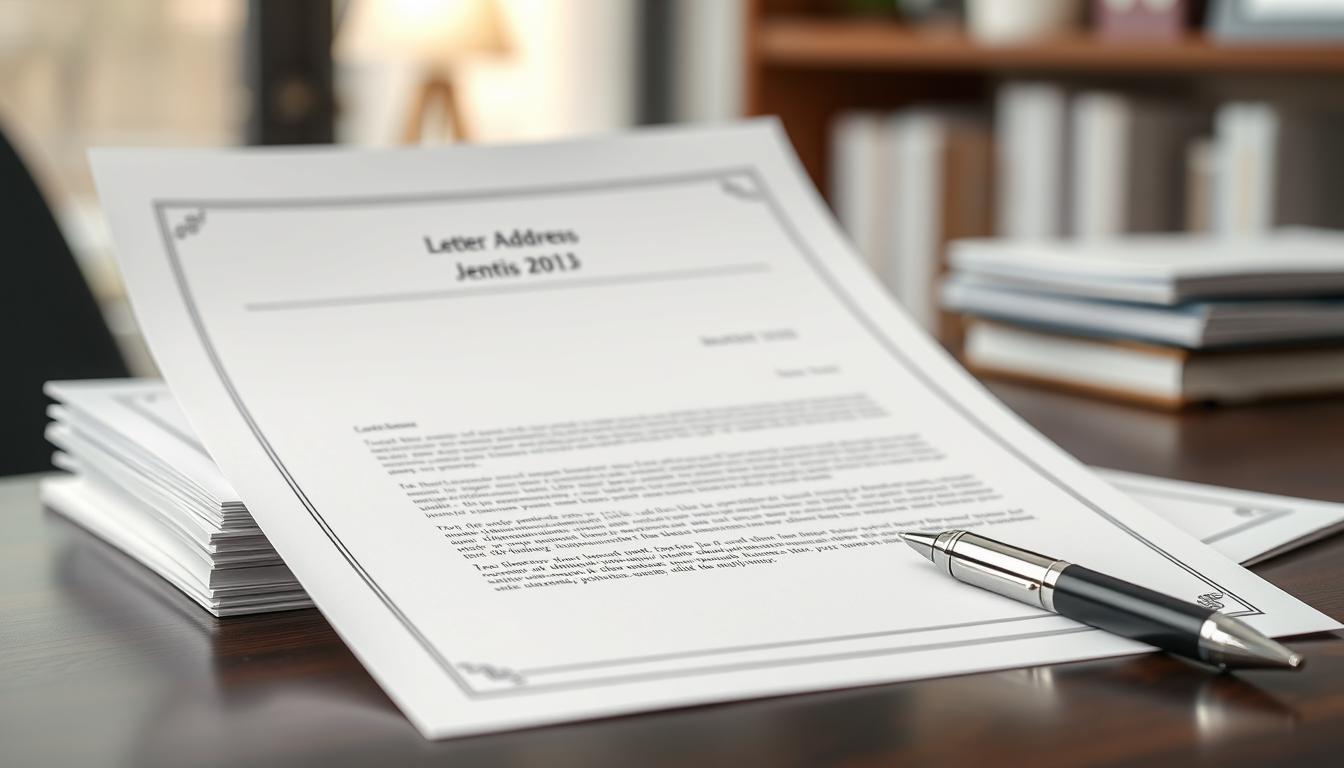Credit reports and inquiries can be complex. This guide offers a free template to address credit report inquiries. It helps you boost your credit score and take charge of your finances.
Our template and expert advice can help with identity theft and loan applications. It simplifies your path to financial success and improves your standing.
Key Takeaways:
- Understand the different types of credit inquiries and their impact on your credit score.
- Learn when to write a letter of explanation for credit inquiries to improve your credit report.
- Discover the essential components of an effective letter of explanation for credit inquiries.
- Gain tips and strategies for writing a compelling letter that addresses any credit report issues.
- Learn how to properly submit and follow up on your letter of explanation to ensure a positive outcome.
Understanding Credit Inquiries and Their Impact
Credit inquiries can shape your financial profile. These requests to access your credit report play a crucial role. Understanding their impact is key to managing your credit effectively.
Types of Credit Inquiries
Credit inquiries come in two main types: hard inquiries and soft inquiries. Hard inquiries happen when you apply for new credit. They can affect your credit score.
Soft inquiries are for background checks or pre-approvals. Unlike hard inquiries, they don’t impact your credit score.
How Credit Inquiries Affect Your Credit Score
Hard inquiries can slightly lower your credit score. The effect is usually small, dropping it by 5 to 10 points. This impact is typically short-lived.
Multiple hard inquiries for mortgages or auto loans are often treated as one. This limits their overall effect on your credit score.
Soft inquiries don’t affect your credit score. Lenders use them for pre-approvals. Employers use them for background checks. They don’t change your credit report or score.
Knowing the difference between inquiry types helps you make smart credit decisions. It can help you minimize negative effects on your financial profile.

“Monitoring your credit report and understanding the different types of credit inquiries can help you maintain a healthy credit score and make informed financial decisions.”
When to Write a Letter of Explanation for Credit Inquiries
A good credit score is vital. Addressing credit inquiries quickly helps maintain it. You should explain credit inquiries in certain situations.
Write a letter if you suspect identity theft. Do the same for errors on your credit report. Provide context for loan applications too.
Act fast if you spot unauthorized inquiries. A letter can document the issue. This protects your credit score from harmful impacts.
Credit report errors can cause unnecessary inquiries. A well-written letter helps fix these mistakes. It safeguards your credit score improvement.
Lenders scrutinize your credit history when you apply for loans. Explaining inquiries gives valuable context. It can boost your approval chances.
“Taking the time to write a letter of explanation for credit inquiries can make a significant difference in maintaining a healthy credit profile and achieving your financial goals.”
Be proactive about credit inquiries. Address them directly. This strategy protects your credit score. It also ensures smooth lending processes later.

Preparing to Write Your Letter of Explanation
Gather key information before writing your credit inquiry explanation letter. This step ensures your letter is well-informed and professional. It will help you address the credit inquiry effectively.
Gathering Necessary Information
Review your credit report to understand the inquiry details. Collect the date of the credit inquiry and the creditor’s name. Note the reason for the inquiry, such as a loan application.
Also, gather any relevant information about the circumstances surrounding the credit inquiry. This will help you provide a complete explanation.
Identifying the Recipient
Determine if you should send your letter to a credit bureau or creditor. If a credit bureau made the inquiry, send your letter there. For lender inquiries, address the letter to that specific lender.
Find contact information on your credit report or the major credit bureaus’ websites. These include Experian, Equifax, and TransUnion.
Proper preparation sets you up for success. By gathering information and identifying the right recipient, you’ll craft an effective explanation letter. This approach helps protect your credit score and addresses the inquiry thoroughly.
Components of an Effective Letter of Explanation
A compelling letter of explanation is crucial for credit report disputes or inquiries. The structure and content of your letter are key. Let’s explore the vital components for presenting your case effectively.
Opening Statement
Your opening statement sets the tone for the letter. It should be brief, engaging, and clearly state your purpose. Capture the reader’s interest and establish your credibility immediately.
Avoid vague openings. Instead, focus on the specific issue you’re addressing.
Explanation of Circumstances
The core of your letter explains the circumstances of the credit inquiry or dispute. Provide a clear, honest account of the events. Present facts logically and include supporting documentation.
Balance persuasion with professionalism. Avoid defensive language and focus on presenting a factual explanation. Highlight steps taken to resolve the issue or prevent future occurrences.
Your goal is to show understanding and convince the recipient to consider your case. A well-crafted letter can effectively advocate for a positive outcome.
Letter of Explanation Credit Inquiry Template
Credit inquiries can be confusing. But don’t worry! We’ve got a tool to help you. Our free template will guide you through explaining credit inquiries on your report.
This template offers a format for writing a professional letter. It helps you address credit inquiry disputes or errors effectively. You can use it to communicate your situation clearly.
Key Components of the Letter of Explanation Template
- Opening statement clearly identifying the purpose of the letter
- Detailed explanation of the circumstances surrounding the credit inquiry
- Requests for the inquiry to be removed or corrected on your credit report
- Closing statement reiterating your request and appreciation for the recipient’s attention
| Sample Letter of Explanation Template |
|---|
Dear [Recipient’s Name], I am writing about a recent credit inquiry on my report. [Explain the circumstances surrounding the inquiry, such as applying for a new credit card or loan, or a potential identity theft incident.] Please remove this credit inquiry from my report. It doesn’t reflect my credit history accurately. It’s also negatively impacting my credit score. Thank you for your attention to this matter. I look forward to resolving this issue soon. Sincerely, [Your Name] |
Feel free to customize this template for your situation. Include any supporting documentation that strengthens your case. This sample letter can help you address credit inquiry disputes more easily.

Tips for Writing a Compelling Letter
A good letter of explanation for credit inquiries needs a smart approach. Clear language and supporting documents are crucial. These elements can make your letter more effective.
Using Clear and Concise Language
For letter of explanation writing tips, keep it simple. Use easy words and short sentences. This helps promote clear communication with the reader.
A clear letter shows you care about credit report disputes. It also helps with credit score improvement. Avoid complex terms that might confuse the reader.
Providing Supporting Documentation
Supporting evidence makes your letter stronger. Gather documents like receipts and statements that back up your explanation. This helps prove your case.
By presenting a well-rounded case, you show you’re serious. It proves you want to address credit inquiries and improve your credit profile.
A good letter with clear writing and proof can solve credit issues. It can lead to positive changes in your credit score.

“A well-crafted letter of explanation can be the key to resolving credit report disputes and improving your overall financial standing.”
Submitting Your Letter of Explanation
Crafting a compelling letter of explanation for credit inquiries is just the first step. Proper submission is key to getting a favorable response from credit bureaus. Ensure your letter reaches the right people for the best outcome.
Credit Bureau Contact Information
Identify the right credit bureau for your letter submission. The three major U.S. credit reporting agencies are Experian, Equifax, and TransUnion. Each has specific contact details and preferences for receiving explanation letters.
- Experian: Address, phone, fax, and online submission details
- Equifax: Address, phone, fax, and online submission details
- TransUnion: Address, phone, fax, and online submission details
Delivery Methods
Use a delivery method that provides proof when submitting your submitting letter of explanation. This ensures timely receipt and processing. Some recommended delivery methods include:
- Certified mail with return receipt
- Overnight delivery service (e.g., FedEx, UPS)
- credit bureau contact information online submission portal
Follow-Up Process
After submission, it’s crucial to check on your follow-up process status. This helps ensure the credit bureau received and is processing your letter. You can follow up by:
- Checking the status of your letter online or by phone
- Requesting a written confirmation of receipt from the credit bureau
- Monitoring your credit report for any changes or updates
Following these steps increases the chances of your explanation letter being accepted. This can help resolve any delivery methods issues affecting your credit score. Keep track of your submissions and stay proactive in the process.
Following Up on Your Letter
Stay proactive after submitting your letter about credit inquiries. Keep an eye on your credit report regularly. This helps you spot new inquiries or score changes quickly.
Monitoring Your Credit Report
Check your credit report from Experian, Equifax, and TransUnion quarterly. This habit ensures you’re up-to-date with your credit report monitoring. It also helps verify that your credit inquiries information is correct.
Addressing Additional Inquiries
Act fast if you see new credit inquiries on your report. Contact the creditor and ask for an explanation. If it’s wrong, start a dispute resolution to remove it.
Stay alert and tackle any credit score updates quickly. This helps maintain your improved credit profile. Persistence is key to success.
Keep monitoring your credit report and addressing new issues. This ensures your letter of explanation resolves initial concerns. It also paves the way for ongoing credit score improvements.
| Action | Benefit |
|---|---|
| Review credit report quarterly | Identify and address new inquiries promptly |
| Dispute inaccurate inquiries | Improve credit score by removing unwarranted entries |
| Follow up on letter of explanation | Ensure the initial credit inquiry concern is resolved |
Preventing Future Credit Inquiries
Maintaining a healthy credit profile is crucial for financial wellbeing. Be selective with credit applications, only choosing accounts you truly need. This approach minimizes hard inquiries on your credit report, protecting your credit score.
Consider enrolling in a credit monitoring service. These services alert you to suspicious activity on your credit report. You can quickly address potential identity theft issues before they worsen.
Develop a budget and pay bills on time. Keep your credit utilization low to show lenders you’re reliable. These habits reduce the need for further inquiries into your creditworthiness.

